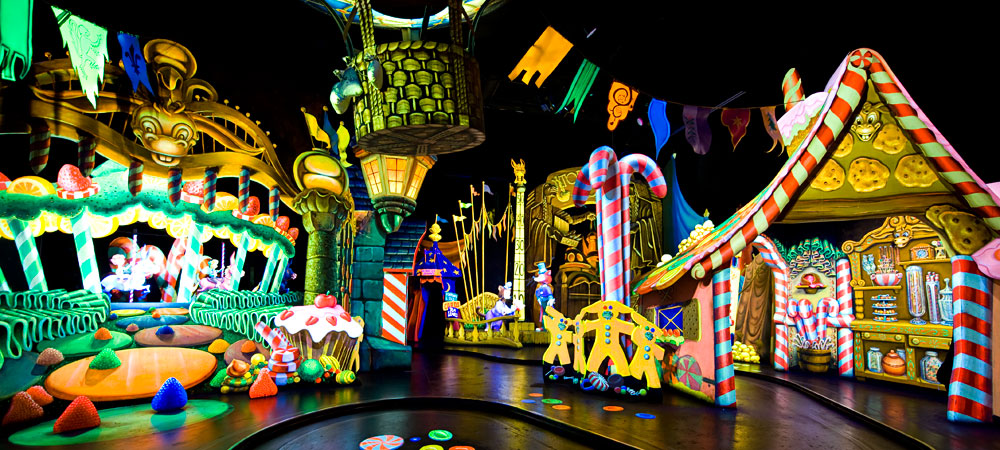 Disney Parks have a couple of meta-attractions, attractions that include representations of miniature amusement parks. Visitors can see how Disney, the most famous of amusement parks, represents its own business. I am going to look at two examples, Pinocchio’s Daring Journey, which ironically warns the visitor against amusement parks, and It’s a Small World, which presents the amusement park as a unifying symbol of humanity.
Disney Parks have a couple of meta-attractions, attractions that include representations of miniature amusement parks. Visitors can see how Disney, the most famous of amusement parks, represents its own business. I am going to look at two examples, Pinocchio’s Daring Journey, which ironically warns the visitor against amusement parks, and It’s a Small World, which presents the amusement park as a unifying symbol of humanity.
Pinocchio’s Daring Journey implicitly criticizes the visitor for indulging in pleasure seeking. The attraction, which opened in 1983, is based on the studio’s 1940 film, which in turn is based on the 1883 book The Adventures of Pinocchio by Carlo Collodi, a story about a selfish, lying wooden puppet who wants to become a real boy. In every version, Pinocchio is a moral tale, teaching children the importance of attending school and avoiding unnecessary distractions. The implication is every human is born selfish (“wooden”) and must learn to control their desires somewhat in order to become a functioning member of society (a “real boy.”)
One of these distractions is an actor’s life, but the biggest and most dangerous distraction is without a doubt Pleasure Island, an amusement park with a Ferris wheel, a carousel, a roller coaster, a hot air balloon, and various games, like hit the bell. Most everything is made out of candy cane, gingerbread, cupcakes and gumdrops with cute donkey characters appearing throughout the park. In short, a child’s paradise!
 However, the amusement park quickly becomes ominous as scary clowns loom over the visitors in their cars with green, leering faces. We see Pinocchio and his friend in silhouette in the window of a pool house. The car enters the pool house (with implications of smoking, drinking and gambling). Pinocchio is laughing at his friend Lampwick who has grown donkey ears. The boy is looking in a mirror, but when he turns towards us, we see he has become a donkey. That is the message here: too much fun can turn you into an ass. As Pinocchio escapes and the donkey boys are carted away to the salt mines, we see the trash of the abandoned amusement park, all the pretense discarded. A strange message to give to amusement park visitors, wouldn’t you agree?
However, the amusement park quickly becomes ominous as scary clowns loom over the visitors in their cars with green, leering faces. We see Pinocchio and his friend in silhouette in the window of a pool house. The car enters the pool house (with implications of smoking, drinking and gambling). Pinocchio is laughing at his friend Lampwick who has grown donkey ears. The boy is looking in a mirror, but when he turns towards us, we see he has become a donkey. That is the message here: too much fun can turn you into an ass. As Pinocchio escapes and the donkey boys are carted away to the salt mines, we see the trash of the abandoned amusement park, all the pretense discarded. A strange message to give to amusement park visitors, wouldn’t you agree?

The It’s a Small World ride portrays the amusement park more positively. The attraction, based on designs by Mary Blair, opened first at the 1964 New York World’s Fair, partly in reaction to the Cuban Missile Crisis. Visitors take a boat ride through rooms representing the peoples of various continents, culminating in the finale, or festival room, where all the peoples of the world mix together. The simple message is that we humans share a small planet, so we should live in peace.

The attraction opened at Disneyland in Anaheim, California in 1966, but it didn’t become a meta-attraction until it opened at Walt Disney World’s Magic Kingdom in 1971. At Walt Disney World, an amusement park with a fanciful roller coaster, a carousel, a Ferris Wheel and hot air balloons was added to the finale room. The message is that amusement parks can help bring the peoples of the world together. With Disney parks in Tokyo, Paris, Hong Kong and Shanghai, it is a hard proposition to refute. Even Khrushchev, head of the Soviet Union during the Cold War, wanted to go to Disneyland. They wouldn’t let him for security reasons. Would the ride have helped to thaw the cold war? Probably not, but the message is still a good one. If the people of the world have fun together, then we should be able to live in peace. In any case, it’s a better message than telling visitors they are wasting their time and should be in school!
These pictures of abandoned amusement parks are super cool: http://metamythic.com/5-eeriest-abandoned-amusement-parks/